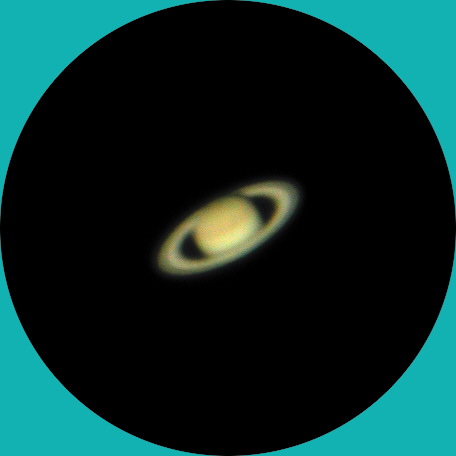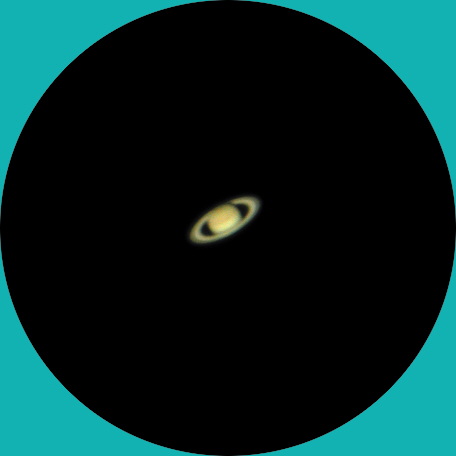
The purpose of this page is to provide you with some idea the view to expect from various size telescopes at various magnifications. For this example we will consider a view of the planet Saturn. First we will show approximately how Saturn might look through three different telescopes operating at magnifications within their useful capability. Then we will show what to expect as a small telescope is pushed beyond its useful magnification range.
Important: It must be remembered that the images on this page are simulated (the image of Saturn is one I took through my Celestron CG-11 scope however). No monitor can cover the brightness range that the telescope (or the human eye for that matter) can see. Thus, do not expect telescope images to appear exactly as those depicted here. The proper calibration and maintenance of the technologies we use will allow us to see an image of the planet's likeness but not an exact account. The main purpose of this page is to provide an approximate comparison of the relative performance of various sized telescopes. Actual views through a real telescope depend on many factors; telescope (and eyepiece) quality and seeing conditions are the two most important determining factors. The simulated images below assume a decent quality eyepiece is being used, one with an apparent field of view of about 50 degrees (in other words, similar to a typical Plossl eyepiece). If nothing else, this page will help to show why any astronomer will tell you that "department store" telescopes (such as Tasco, Jason, Bushnell, etc) cannot show quality images at the preposterous magnification capability claimed by these instruments!
If the calibration bar below does not show 16 distinct shades of gray, the images on this page will not display in an ideal manner!


This is the reference image. This image of Saturn was taken through a Celestron CG-11 telescope. This is about how Saturn looks through the scope when it is at about 400x magnification on a night of good seeing and with the scope thermally stable.

This image simulates how Saturn would look through a 5 inch telescope operating at about 200x magnification. Note that the image is the same brightness as the image in the 11 inch scope above, however Saturn appears quite a bit smaller. Because the smaller scope gathers less light, the image size (magnification) must be reduced in order to hold the same brightness as the larger scope.

This image simulates how Saturn would look through a smaller telescope such as a typical 80mm scope (roughly 3 inch) at about 100x. The image is the same brightness as that of the 11 inch scope but it is obviously a lot smaller. As before, because the smaller scope gathers less light, the image must be a lot smaller to hold the same brightness level as that of the larger scope.

This image shows what Saturn might look like with a 5 inch scope pushed to 400x. Note that the image is quite a bit dimmer than that of the 11 inch scope. This is because the smaller scope gathers less light, and this means that the image will be a lot less bright because the smaller amount of available light has to be spread through the larger image. Note: if you have a high quality refractor (like Astro Physics, Takahashi, TeleVue, etc.) the image will almost certainly appear better than that shown here. The image above would be typical of a 5" Schmidt Cassegrain telescope or a Newtonian Reflector scope.

This image shows what happens when a smaller scope is pushed way beyond its useful magnification range. Here we show what Saturn might look like through a small scope when the magnification is at about 400x, and this is quite a bit less than the 675x claimed by some low end telescope makers (Tasco, Bushnell, Jason, etc)! The image above is so dim that little or no detail can be seen. Would you want to look at Saturn if it looked like this? This assumes that you could even keep the image centered in the narrow field low quality eyepieces that come with low end scopes...
From the above we draw the following conclusions...
Use your browser's "back" button, or use links below if you arrived here via some other path:
This page is part of the site Amateur Astronomer's Notebook.
E-mail to Joe
Roberts
Images and HTML text © Copyright 2001 by Joe Roberts. Please request permission to use photos for purposes other than "personal use".